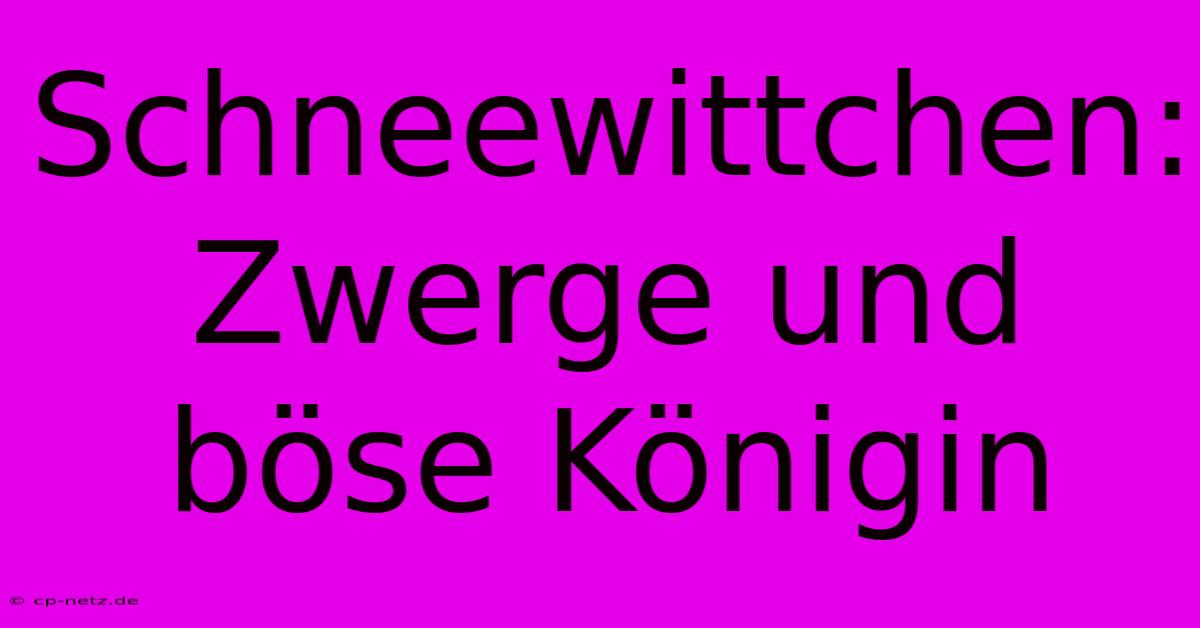Schneewittchen: Zwerge Und Böse Königin

Discover more detailed and exciting information on our website. Click the link below to start your adventure: Visit Best Website Schneewittchen: Zwerge Und Böse Königin. Don't miss out!
Table of Contents
Schneewittchen: Zwerge, böse Königin und die Magie der Märchen
Hey Leute! Let's talk about Schneewittchen – Snow White, right? I mean, who didn't grow up with this classic fairy tale? It’s practically ingrained in our collective consciousness. But have you ever really thought about the story? I mean, beyond the poisoned apple and the prince charming? It's way more complex than it seems at first glance, and that’s what makes it so enduring.
Die sieben Zwerge: Mehr als nur Kumpel
We all remember the seven dwarfs: Doc, Grumpy, Happy, Sleepy, Bashful, Sneezy, and Dopey. They're, like, the ultimate bro squad, right? But digging a little deeper, these guys are way more interesting than just comic relief. They represent different aspects of human nature. Grumpy's cynicism, Happy's optimism... it’s like a little microcosm of society living in that cozy little cottage. Think about it – they're miners, hard workers, living a simple life, yet they’re completely capable of compassion and offering Schneewittchen shelter and protection. That’s pretty rad, right?
I used to think they were just a bunch of silly cartoon characters when I was younger. Then, in college, I wrote a paper analyzing their individual personalities and the symbolism they represented within the broader context of the fairy tale. It was a real eye-opener! It helped me appreciate the depth and complexity of the story. I even included analysis of the gender roles and how they reflected the societal norms of the time. It got a pretty good grade. Yay for me!
Practical Tip: Uncover Deeper Meanings
When you’re analyzing fairy tales, or really any story, look for symbolism. What do the characters represent? What are the underlying themes? You’ll be amazed at what you discover. Seriously, try it. It makes these stories far more engaging and thought-provoking than just a simple "happily ever after."
Die böse Königin: Ein Spiegelbild der Gesellschaft?
Then there’s the evil queen. She's the quintessential villain, obsessed with beauty and power. But again, she’s more than just a one-dimensional bad guy. The magic mirror, the poisoned apple – these are all powerful symbols. The mirror reflects her own insecurities and vanity, her desperate need for validation. The poisoned apple? Well, that’s a whole other can of worms! It’s a pretty dark symbol, representing jealousy, deceit, and ultimately, death.
Remember, these stories are not just for kids. They reflect the struggles, fears, and desires of all of humanity. The Queen’s obsession with youth and beauty is a relatable fear; everyone worries about aging, right?
Practical Tip: Analyze the Villain’s Motivations
Don’t just dismiss the villain as simply "evil." Try to understand their motivations. What drives them? What are their fears and insecurities? Understanding the villain makes the story richer and more compelling. And let's be honest, sometimes the villain is the most interesting character.
Schneewittchen und der Prinz: Eine klassische Romanze?
Okay, so the prince... He's a bit of a cliché, isn't he? He arrives, kisses Schneewittchen, and that’s it. Poof happily ever after. But even the prince serves a purpose, a bit of an unsatisfying one. He’s essentially the plot device that saves the day. He's the symbol of rescue and the happy ending we all crave. But, let's be honest, he's a bit of a damsel in distress saver.
Practical Tip: Question the Tropes
Don't just accept the classic tropes. Think critically about them. What are the strengths and weaknesses of the narrative structure? This critical thinking helps you appreciate the story better and also develop your analytical skills.
So, yeah. That’s my take on Schneewittchen. It's more than just a fairy tale – it's a complex story that continues to fascinate and inspire. What are your thoughts? Let’s chat in the comments below!

Thank you for visiting our website wich cover about Schneewittchen: Zwerge Und Böse Königin. We hope the information provided has been useful to you. Feel free to contact us if you have any questions or need further assistance. See you next time and dont miss to bookmark.
Featured Posts
-
Guardiola Cl Aus Naechster Rueckschlag 29 Zeichen
Nov 27, 2024
-
Folge 90 Feux De L Amour S26
Nov 27, 2024
-
Kjell Gruner Vw Usas Zukunft
Nov 27, 2024
-
Nachhaltig Wirtschaften Zukunftswegweiser
Nov 27, 2024
-
Kinderheirat Cdu Muss Handeln
Nov 27, 2024
